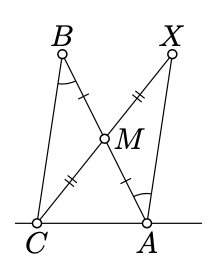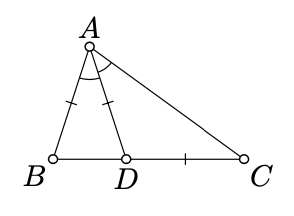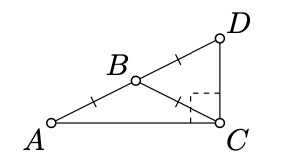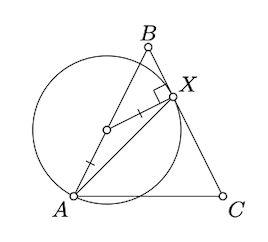7.4: Ángulos de triángulos
- Page ID
- 114416
En cualquiera\(\triangle ABC\), tenemos
\(\measuredangle ABC + \measuredangle BCA + \measuredangle CAB \equiv \pi.\)
- Prueba
-
Primero tenga en cuenta que si\(\triangle ABC\) es degenerado, entonces la igualdad se desprende del Corolario 2.4.1. Además suponemos que no\(\triangle ABC\) es degenerado.

Dejar\(X\) ser el reflejo de\(C\) a través del punto medio\(M\) de\([AB]\). Por Proposición 7.2.1\(\measuredangle BAX = \measuredangle ABC\). Tenga en cuenta que\((AX)\) es un reflejo de lo\((CB)\) ancho\(M\); por lo tanto por el Teorema 7.2.1,\((AX) \parallel (CB)\).
Desde\([BM]\) y\([MX]\) no se cruzan\((CA)\), los puntos\(B, M\), y\(X\) se encuentran en el mismo lado de\((CA)\). Aplicando la propiedad transversal para\((CA)\) lo transversal a\((AX)\) y\((CB)\), obtenemos que
\[\measuredangle BCA + \measuredangle CAX \equiv \pi.\]
Desde entonces\(\measuredangle BAX = \measuredangle ABC\), tenemos
\(\measuredangle CAX \equiv \measuredangle CAB + \measuredangle ABC\)
Esta última identidad y 7.4.1 implican el teorema.

Dejar\(\triangle ABC\) ser un triángulo no degenerado. Supongamos que hay un punto\(D \in [BC]\) tal que
\(\measuredangle BAD \equiv \measuredangle DAC, BA = AD = DC.\)
Encuentra los ángulos de\(\triangle ABC\).
- Sugerencia
-
Aplicar dos veces Teorema 4.3.1 y dos veces Teorema\(\PageIndex{1}\).
Demostrar que
\(|\measuredangle ABC| + |\measuredangle BCA| + |\measuredangle CAB| = \pi\)
para cualquier\(\triangle ABC\).
- Sugerencia
-
Si\(\triangle ABC\) es degenerado, entonces una de las medidas de ángulo es\(\pi\) y las otras dos son 0. De ahí el resultado.
Supongamos que no\(\triangle ABC\) es degenerado. Establecer\(\alpha = \measuredangle CAB\),\(\beta = \measuredangle ABC\), y\(\gamma = \measuredangle BCA\).
Por el Teorema 3.3.1, podemos suponer que\(0 < \alpha, \beta, \gamma < \pi\). Por lo tanto,
\[0 > \alpha + \beta + \gamma < 3 \cdot \pi.\]
Por teorema\(\Pageindex{1}\),
\[\alpha + \beta +\gamma \equiv \pi.\]
De 7.4.2 y 7.4.3 sigue el resultado.
Dejar\(\triangle ABC\) ser un triángulo no degenerado de isóselas con la base\([AC]\). Supongamos que\(D\) es un reflejo de\(A\) lo ancho\(B\). Demuestre que\(\angle ACD\) es correcto.

- Sugerencia
-
Aplicar dos veces Teorema 4.3.1 y dos veces Teorema\(\PageIndex{1}\).
Dejar\(\triangle ABC\) ser un triángel isósceles no degenerado con base\([AC]\). Supongamos que un círculo está pasando\(A\), centrado en un punto sobre\([AB]\), y tangente a\((BC)\) en el punto\(X\). \(\measuredangle CAX = \pm \dfrac{\pi}{4}\)Demuéstralo.
- Sugerencia
-

Supongamos que\(O\) denota el centro del círculo.
Tenga en cuenta que\(\triangle AOX\) es isósceles y\(\angle OXC\) tiene razón. Aplicando Teorema\(\PageIndex{1}\) y Teorema 4.3.1 y simplificando, deberíamos obtener\(4 \cdot \measuredangle CAX \equiv \pi\).
Demostrar que\(\angle CAX\) tiene que ser agudo. De ello se deduce entonces eso\(\measuredangle CAX = \pm \dfrac{\pi}{4}\).
Demostrar que para cualquier cuadrilátero\(ABCD\), tenemos
\(\measuredangle ABC + \measuredangle BCD + \measuredangle CDA + \measuredangle DAB \equiv 0\).
- Sugerencia
-
Aplicar Teorema\(\PageIndex{1}\) a\(\triangle ABC\) y\(\triangle BDA\).


